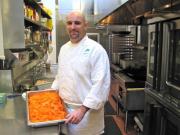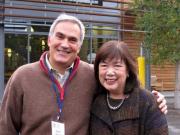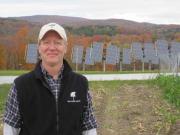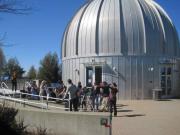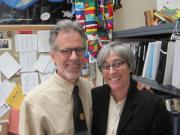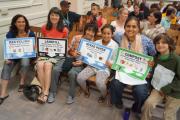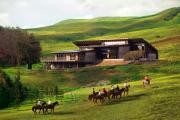Green Schools: California Greening
In the spring I continued my journey in search of best green practices in California public and private schools. Here are stories of four remarkable schools making a difference, in order I visited them: Katherine Delmar Burke School, Drew School, Midland School, Glenview Elementary School, and Rosa Parks Elementary School.
1. Katherine Delmar Burke School: Inspiring Students to Action
At the Katherine Delmar Burke School, a K-8 independent school of 400 girls in San Francisco, parents, Board members and faculty have joined together to promote a more sustainable school. Taking to heart the school’s mission to “educate, encourage, and empower” girls, Burke’s is taking a leadership role in environmental sustainability in all areas from policy to practice.
Taking to heart the school’s mission to “educate, encourage, and empower” girls, Burke’s is taking a leadership role in environmental sustainability in all areas from policy to practice.
Helping to lead the process is Jennifer Caldwell, Burke’s parent and an environmental activist in her own right. A graduate of Sarah Lawrence College, she moved to San Francisco and served as director of marketing at the Nature Conservancy of California. After starting her family, she then founded Hope to Action: Women for a Greener Planet, to encourage “the primary drivers of household purchasing and lifestyle decisions” to embrace the “change our nation needs to meet its goals for environmental sustainability.” A member of the Board at Burke’s, Caldwell has helped shape high expectations for the school’s environmental initiatives.
After starting her family, she then founded Hope to Action: Women for a Greener Planet, to encourage “the primary drivers of household purchasing and lifestyle decisions” to embrace the “change our nation needs to meet its goals for environmental sustainability.” A member of the Board at Burke’s, Caldwell has helped shape high expectations for the school’s environmental initiatives.
In 2008, the Burke’s Board of Trustees adopted a “Policy Statement on Environmental Sustainability” that declares: the “School is committed to nurturing lifelong values of environmental responsibility and stewardship in our students through the education and practices of sustainability at our school, and to fostering in students a strong connection with nature in order to prepare them for meaningful engagement with environmental issues throughout their lives.”  Concerned about “increasing environmental concerns on both the local and global level,” Burke’s has declared its commitment to “environmental education, sustainability and stewardship as an integral part of a 21st century education.”
Concerned about “increasing environmental concerns on both the local and global level,” Burke’s has declared its commitment to “environmental education, sustainability and stewardship as an integral part of a 21st century education.”
The Board’s commitment has led to some significant changes at the school, especially in the areas of facilities, operations and food. In a recent newsletter to the school community, Head of School Kim Wargo noted many improvements, including systematic initiatives to improve transportation efficiency through carpools, bus, and a bike-to-work incentive program.  New construction was designed with energy efficiency features, motion-sensitive light monitors are being installed, and the school has commissioned a comprehensive energy audit. Recycling programs, paperless communications, and guidelines for waste-free lunches and class parties are taking hold. Lower School science teacher Elizabeth MacDonald has prepared a clever video on “how to sort your trash.” And the new food service hopes to incorporate local, seasonal produce into the menus, including vegetables from the school’s garden.
New construction was designed with energy efficiency features, motion-sensitive light monitors are being installed, and the school has commissioned a comprehensive energy audit. Recycling programs, paperless communications, and guidelines for waste-free lunches and class parties are taking hold. Lower School science teacher Elizabeth MacDonald has prepared a clever video on “how to sort your trash.” And the new food service hopes to incorporate local, seasonal produce into the menus, including vegetables from the school’s garden.
This Earth Day I was honored by the invitation from Assistant Head Roz Benjamin to serve as speaker for the Burke’s Middle School. I reminded the girls that we gathered to celebrate a day set aside over 40 years ago to consider the fragile global environment and how to protect it, a perspective we gained when Apollo 17 beamed pictures back to Mission Control showing the blue and green orb in a jet-black universe. Encouraging their leadership, I shared with them examples of students around the Bay Area making a difference in their schools.  This year’s leaders of the new student Green Team, Julia Wei and Zoe Klawans, told me that their club has 50 members involved in many projects to green the campus.
This year’s leaders of the new student Green Team, Julia Wei and Zoe Klawans, told me that their club has 50 members involved in many projects to green the campus.
The Burke’s School declares that its commitment to sustainability also “reflects the responsibility we recognize to lead by example in our broader community.” With the leadership of Jennifer Caldwell, Burke’s has helped establish a network of green schools in Northern California working collaboratively to promote sustainability initiatives. Indeed, following the motto to “educate, encourage, and empower”, Burke’s is helping to promote sustainability as a value, and as a practice, in Bay Area independent schools.
2. New Roots for the Drew School
In April 2011 the Drew School, a 9-12 independent high school for 250 students in San Francisco, celebrated the culmination of two decades’ effort to re-envision the school and to build a new campus on the site where it was located a century ago.  Called the “New Roots project,” Drew dedicated the new LEED Gold Samuel M. Cuddeback III Assembly Wing in honor of its long-term Head of School. While the building itself features many environmentally sustainable features including a “living wall,” the project has infused new life into this college preparatory academy.
Called the “New Roots project,” Drew dedicated the new LEED Gold Samuel M. Cuddeback III Assembly Wing in honor of its long-term Head of School. While the building itself features many environmentally sustainable features including a “living wall,” the project has infused new life into this college preparatory academy.
Sam Cuddeback’s vision for the school and his commitment to environmental sustainability was shaped growing up in New England.  After receiving his undergraduate degree from Dartmouth, he taught at-risk middle school youth in Vermont, and then joined the faculty at Tabor Academy, a boarding school in Massachusetts where he developed a belief in the power of an educational community, as a faculty member, dorm parent and coach. But it was his work as resident caretaker at the nearby Wellfleet Historical Society, where he directed a small farm with goats, chickens and a productive garden, that planted the seed for his later interest in environmental sustainability at Drew.
After receiving his undergraduate degree from Dartmouth, he taught at-risk middle school youth in Vermont, and then joined the faculty at Tabor Academy, a boarding school in Massachusetts where he developed a belief in the power of an educational community, as a faculty member, dorm parent and coach. But it was his work as resident caretaker at the nearby Wellfleet Historical Society, where he directed a small farm with goats, chickens and a productive garden, that planted the seed for his later interest in environmental sustainability at Drew.
Gazing up at the new assembly wing from the street, one’s eye meets the building’s most innovative feature, the “living wall” designed by French botanist Patrick Blanc. The forty-foot high green wall contains over 4000 plants, all native species that are “fertigated” by a constant flow of water that is mostly recycled in a continuous irrigation loop.  Blanc’s living wall is his first in the United States, out of nearly 250 world-wide, and represents an innovative approach to urban design by expanding the opportunities to green the world’s growing cities; in Drew’s case more than 30% of the building surface is devoted to vegetation. The new wing also features a “living roof” by the Rana Creek group, who designed the 2.5 acre green roof at the nearby California Academy of Sciences. The school estimates that the green roof and wall will provide a 15% energy reduction in the winter and 85% in the summer. The LEED certified building has many other green features that include daylighting through glazed, operable windows and courtyard doors, light-fixture monitors, advanced HVAC systems, and bamboo flooring.
Blanc’s living wall is his first in the United States, out of nearly 250 world-wide, and represents an innovative approach to urban design by expanding the opportunities to green the world’s growing cities; in Drew’s case more than 30% of the building surface is devoted to vegetation. The new wing also features a “living roof” by the Rana Creek group, who designed the 2.5 acre green roof at the nearby California Academy of Sciences. The school estimates that the green roof and wall will provide a 15% energy reduction in the winter and 85% in the summer. The LEED certified building has many other green features that include daylighting through glazed, operable windows and courtyard doors, light-fixture monitors, advanced HVAC systems, and bamboo flooring.
For Cuddeback and his team, the new facilities will allow Drew to “spread its roots” by using the green building to enhance the school’s marketing, academic program, community partnerships. Admission Director Elizabeth Tilden “ET” Baier says there will be a definite impact of what she calls “lean and nice” on the school’s marketing efforts as “green is a real selling point with our families.” She also points to Drew’s decision to become an “iPad school” this fall and estimates that the decision to have all textbook materials on line will save approximately $40,000 annually. With many students coming to school by public transportation, and with 42% of the students receiving financial assistance, Drew for her models financial sustainability.  Her colleague Cat Meyers, a biology and Spanish teacher with a Ph.D. from UC Berkeley in population genetics, is excited about the opportunities the new green building will open up for the curricular program. Already she has established a partnership with the California Academy of Sciences for regular exchange field trips. She believes the school’s environmental sustainability commitment will foster the development of more courses like her special week-long seminar called “How much do you like your chicken dinner?’ that gives students a chance to experience and understand where food comes from, by creating meals from locally harvested wild plants, a deep sea fishing expedition, and live chickens the students prepare for their final dinner. She also points to her fellow biologist Warren Long’s Climate Change Initiative, a teacher development seminar he has taught around the world, and the creation of the student Environmental Club this year, as a sign of Drew’s new direction.
Her colleague Cat Meyers, a biology and Spanish teacher with a Ph.D. from UC Berkeley in population genetics, is excited about the opportunities the new green building will open up for the curricular program. Already she has established a partnership with the California Academy of Sciences for regular exchange field trips. She believes the school’s environmental sustainability commitment will foster the development of more courses like her special week-long seminar called “How much do you like your chicken dinner?’ that gives students a chance to experience and understand where food comes from, by creating meals from locally harvested wild plants, a deep sea fishing expedition, and live chickens the students prepare for their final dinner. She also points to her fellow biologist Warren Long’s Climate Change Initiative, a teacher development seminar he has taught around the world, and the creation of the student Environmental Club this year, as a sign of Drew’s new direction.
Cuddeback speaks candidly about the challenges and opportunities that lie ahead for Drew. The $15 million dollar cost of the new building was increased with the special features of the living wall and roof, but he calls the Board’s decision to pursue the vision of a green building its “highest moral moment.”  He credits the 2003 NAIS sustainablility imperative—financial, demographic, programmatic, global and environmental—as “reframing school life in a compelling way” for member schools. He also believes that without the investment Drew has made in its new, green facilities the school’s place in the private school market would not be as secure.
He credits the 2003 NAIS sustainablility imperative—financial, demographic, programmatic, global and environmental—as “reframing school life in a compelling way” for member schools. He also believes that without the investment Drew has made in its new, green facilities the school’s place in the private school market would not be as secure.
It is exciting to see Drew School’s efforts to become more sustainable. Clearly, the school is establishing “new roots” for itself, and by its example, for the wider world educational community.
3. Midland School: Environmental Sustainability in the DNA
When I met Lise Goddard, Director of Environmental Programs at Midland School, this winter at the Green Schools Alliance meeting in Southern California this January, I learned about a remarkable boarding school for approximately 100 students school that was founded in 1932 on the principles of sustainability.  As their Head of School Will Graham observes, at Midland “environmental sustainability is in our DNA.” Although I was not able to visit the school firsthand, my extended conversation with Midland’s leaders enabled me to see that the school offers a unique program for high school students, one deeply rooted in the past but embracing cutting edge principles.
As their Head of School Will Graham observes, at Midland “environmental sustainability is in our DNA.” Although I was not able to visit the school firsthand, my extended conversation with Midland’s leaders enabled me to see that the school offers a unique program for high school students, one deeply rooted in the past but embracing cutting edge principles.
When Paul and Louise Squibb founded Midland in 1932, they chose a magnificent place for the campus, 2860 acres of land adjacent to the Los Padres National Forest in Los Olivos, California. The school’s mission has long emphasized “the value of a lifetime of learning, self-reliance, simplicity, responsibility to community and the environment and love for the outdoors.”  Those who teach and learn at Midland today embrace a philosophy of sustainability: “a simple, self-reliant lifestyle, close to nature, teaches us to develop our inner resources, to distinguish between needs and wants, and to appreciate life’s fundamental joys and challenges.” “Connection to the environment,” they note, “teaches students to be good stewards of the earth.”
Those who teach and learn at Midland today embrace a philosophy of sustainability: “a simple, self-reliant lifestyle, close to nature, teaches us to develop our inner resources, to distinguish between needs and wants, and to appreciate life’s fundamental joys and challenges.” “Connection to the environment,” they note, “teaches students to be good stewards of the earth.”
The team of Goddard and Graham is carrying on the Midland founders’ legacy. As Lise Goddard notes, this has been a team effort involving everyone from “the ranch manager to the cooks who cherish the garden's produce…we are standing on the shoulders of remarkable forward-thinkers and are merely helping to articulate the school's place in the 21st century, based upon a rich history and legacy of stewardship.” Nonetheless, it is clear that these two leaders have made a big difference.  Lise Goddard herself was raised in Ithaca, New York, in a family with several generations of scientists, and she grew up with the “backdrop of some pretty spectacular countryside.” After receiving her B.A. from Stanford in human biology, and graduate work in marine biology at UC Santa Barbara, she began teaching in the East and came to Midland to teach chemistry and to fashion their environmental sustainability program. Also raised in the East where his mother taught at Bancroft School in Worcester, Massachusetts, Will Graham developed a strong belief in the role community plays in education, as a student at Holderness School in Plymouth, New Hampshire, earning his B.A. and M.A. from Middlebury College, and teaching at Gould Academy in Maine, where the headmaster instilled in him the idea that “kids find their power through the environment.”
Lise Goddard herself was raised in Ithaca, New York, in a family with several generations of scientists, and she grew up with the “backdrop of some pretty spectacular countryside.” After receiving her B.A. from Stanford in human biology, and graduate work in marine biology at UC Santa Barbara, she began teaching in the East and came to Midland to teach chemistry and to fashion their environmental sustainability program. Also raised in the East where his mother taught at Bancroft School in Worcester, Massachusetts, Will Graham developed a strong belief in the role community plays in education, as a student at Holderness School in Plymouth, New Hampshire, earning his B.A. and M.A. from Middlebury College, and teaching at Gould Academy in Maine, where the headmaster instilled in him the idea that “kids find their power through the environment.”
The environmental commitment at Midland is expressed in the Environmental Action Plan the school adopted in 2009, which observes that “in this age of increasing concern about our environment, Midland students learn, through academic and everyday example, to be good stewards of the Earth.”  The Action Plan outlines 20 specific commitments for the school, beginning with a goal of eventual carbon neutrality. The plan covers all the key components of a green school: facilities (energy conservation, efficiency, on-site renewable energy, sustainable buildings), food (producing a wide variety of produce and grass fed beef on the school’s farm), operations (rotational grazing practices, hazardous waste treatment, land conservation, recycling, composting, efficient transportation, water conservation), and program (classes focus on environmental themes and take advantage of a “campus that becomes part of the classroom”). The just-approved Strategic Plan reinforces the school’s commitment to developing an environmental academic program, declaring that Midland will “continue to implement an environmentally-based curriculum within a college preparatory program, emphasizing that Midland’s educational landscape includes every aspect of our daily lives.”
The Action Plan outlines 20 specific commitments for the school, beginning with a goal of eventual carbon neutrality. The plan covers all the key components of a green school: facilities (energy conservation, efficiency, on-site renewable energy, sustainable buildings), food (producing a wide variety of produce and grass fed beef on the school’s farm), operations (rotational grazing practices, hazardous waste treatment, land conservation, recycling, composting, efficient transportation, water conservation), and program (classes focus on environmental themes and take advantage of a “campus that becomes part of the classroom”). The just-approved Strategic Plan reinforces the school’s commitment to developing an environmental academic program, declaring that Midland will “continue to implement an environmentally-based curriculum within a college preparatory program, emphasizing that Midland’s educational landscape includes every aspect of our daily lives.”
To make environmental sustainability a reality in the students’ lives, Lise Goddard launched a pilot project in 2003 to have her 10th grade chemistry students work with a professional solar electrician to install a 3-kW PV system on campus.  She was inspired by the solar system she and her husband earlier installed on their Santa Barbara home. After teaching the students about the physics of solar power in the classroom, she has led each of her subsequent classes in the project. As of 2011 20% of the school’s electricity needs are being met by the sun, and they plan to continue building until becoming grid neutral.
She was inspired by the solar system she and her husband earlier installed on their Santa Barbara home. After teaching the students about the physics of solar power in the classroom, she has led each of her subsequent classes in the project. As of 2011 20% of the school’s electricity needs are being met by the sun, and they plan to continue building until becoming grid neutral.
In 2009 Midland School was awarded California’s highest environmental honor, the Governor’s Environmental and Economic Leadership Award (GEELA), the only school so recognized. The award “recognizes individuals, organizations and businesses that have demonstrated exceptional leadership for voluntary achievements in conserving California's resources, protecting and enhancing the environment and building public-private partnerships.” With its historic commitment to environmental sustainability, Midland School is clearly an example for other schools to study, and to emulate.
4. Going Green at Glenview
Walking into the brightly painted Glenview Elementary School, a K-5 school for 435 students nestled in tree-lined neighborhood in the Oakland hills, one is greeted by a sign that declares, “We can’t hide our Glenview pride.” Indeed, newly-appointed principal Natalie Walchuk and her faculty and parent team have much to be proud of at this public school that demonstrates how community-based school reform, supported by an environmental sustainability theme, can produce significant improvements in student achievement.
Glenview serves a multicultural community that mirrors the face of Oakland; a third of the students are European-American, a quarter African-American, Latinos and Asians a sixth each. In recent years the Academic Performance Index has risen above 800, well above the district average, attendance is 96%, attrition is low, 89% of students are satisfied with their school, and 96% of parents say they are encouraged to participate in school activities or meetings. The move to embrace environmental sustainability has been headed by parents and resulted in improved recycling, composting, garden, and food service initiatives.
Two parents who have helped lead the change described their engagement at Glenview School. Christy Getz is a professor a UC Berkeley in the College of Environmental Sciences. With a PhD from Berkeley in the sociology of food and agriculture, she has focused her work on food system issues, and with her husband, who is an ecologist, is a strong proponent of the public schools. She is currently working on efforts to improve nutrition and access to healthy food in the district with the Oakland School Food Alliance, a group of activists and school officials who are shaping policy to bring to the city’s schoolchildren, 80% of whom qualify for “free and reduced lunch,” food that is more local, organic and healthy. She also works with the Oakland Food Web, a pilot project of four schools supported by the Center for Ecoliteracy and the S.D. Bechtel Foundation, that are taking a holistic approach that encourages schools gardens, farmers markets, and nutrition education. As a result of the work of Getz and her fellow parents, Glenview has a beautiful edible garden and a produce stand that enables family to buy produce in front of the school.
Another member of the parent Green Team, Eric Londgren, has helped to spearhead a comprehensive recycling program. Raised in Tacoma with a degree from the University of Washington, he and his wife Pam, herself a former teacher and education researcher, moved to the Glenview district before having children and were impressed by the changes taking place to make the school more of a community. Londgren helped organize the comprehensive recycling and composting program that is saving the school significant money by reducing the number of garbage off-haul trips. He and fellow parents produced a snappy video, Scrap It, featuring student workers who monitor the recycling stations and the popular custodian, Mr. Fudge. Londgren and his Green Team members hope the district will find a way to return the savings to the school site itself to support other environmental initiatives, like the recently instituted effort to reduce the transportation impact through events like the Walk and Roll to School Day.
This year Natalie Walchuk arrived at Glenview as the new principal and has brought vibrant energy and passion for sustainability initiatives. A product of the Catholic schools in Richmond, she earned her undergraduate degree from UC Berkeley and advanced degrees from St. Mary’s and Cal State East Bay, while teaching in every grade from kindergarten to twelfth. With a long-held commitment to environmental justice, she hopes to inspire her faculty and students to become “environmental stewards.” Commenting that “we can’t work in pockets,” she outlined her vision of an integrated curriculum that incorporates sustainability in all subjects. Walchuk identified the many ways environmental themes are already incorporated in the program: a spiraled scope and sequence in the science classes supported by the FOSS curriculum developed by the Lawrence Hall of Science, the use of local sites like nearby Dimond Park to support place-based learning, participation in the Solar School Program that uses a PV cell on campus to teach student about energy use in real-time, the green theme in the recent science fair where participation doubled from last year, a Four Rs assembly to reinforce the on waste reduction and efficiency, and a host of field trips to sites around the Bay Area from the Discovery Center in San Jose to the Marine Mammal Center in Marin County.
Natalie Walchuk and her parent team note the significant challenges they face in a district that has struggled with a state takeover, declining enrollment, a wave of youth crime, and the current financial crisis. But she is encouraged by the strong leadership of Superintendent Tony Smith and the progress that is being made in the district. Together she and her team are hopeful about the improvements underway at Glenview, where the green theme is helping boost achievement, reduce costs and build community.
5. Rosa Parks: A Green Star School
Rosa Parks School, a K-5 elementary school of 435 students in Berkeley, CA, shows how a carefully designed program to support the “greening” of a school can enhance its academic program, healthy environment, nutritional food, and community engagement.  Led by Deborah Moore, executive director of the Green Schools Initiative, and her associate, Susan Silber, the school served this year as a pilot project for the Green Star Schools Program, designed to recognize schools for environmental sustainability in facilities, operations, and curricula.
Led by Deborah Moore, executive director of the Green Schools Initiative, and her associate, Susan Silber, the school served this year as a pilot project for the Green Star Schools Program, designed to recognize schools for environmental sustainability in facilities, operations, and curricula.
In recent years Rosa Parks School has embraced an environmental theme. After suffering damage in the Loma Prieta earthquake twenty years ago, it was rebuilt as an environmental science magnet school, with attractive, village-like campus facilities that include a cluster of nine small houses for the classrooms surrounding a central administration and classroom building. 
 Through a special community fundraising initiative and significant parent involvement it was equipped with a science lab. A dedicated parent, environmental planner, and author of Asphalt to Ecosystems, Sharon Danks helped craft many attractive green schoolyard features, including an on-site edible schoolyard, a geology garden, a demonstration solar pond and native plantings. The school’s science specialist, Suzanne Ingley, developed a K-5 environmental science program focused on the study of nature’s cycles and systems, environmental concerns. Her work has been supported by a gardening and cooking teacher, Tanya Stiller.
Through a special community fundraising initiative and significant parent involvement it was equipped with a science lab. A dedicated parent, environmental planner, and author of Asphalt to Ecosystems, Sharon Danks helped craft many attractive green schoolyard features, including an on-site edible schoolyard, a geology garden, a demonstration solar pond and native plantings. The school’s science specialist, Suzanne Ingley, developed a K-5 environmental science program focused on the study of nature’s cycles and systems, environmental concerns. Her work has been supported by a gardening and cooking teacher, Tanya Stiller.
Like many urban schools, Rosa Parks has experienced challenges. The student body is diverse—it has a third each Hispanic and Caucasian students, an eighth African-American, and a fifth multiracial—and includes families that range from UC Berkeley professors to the homeless. Only a fifth of the students have achieved grade level on standardized tests in recent years. There have been six principals in eight years and frequent “restructurings.”
The school’s new principal, Paco Furlan, came to Berkeley in 2010 after a decade serving successfully as an administrator and principal for two elementary schools in Eugene, OR.  Raised in Seattle, where his mother was an elementary teacher, Furlan early became an environmental activist and worked for the Washington Public Interest Research Group before becoming a teacher. He brought with him a belief in the value of environmental education and notes that Riverwood Elementary School in Eugene was recognized by the Oregon green schools program.
Raised in Seattle, where his mother was an elementary teacher, Furlan early became an environmental activist and worked for the Washington Public Interest Research Group before becoming a teacher. He brought with him a belief in the value of environmental education and notes that Riverwood Elementary School in Eugene was recognized by the Oregon green schools program.
Building on this foundation, the team from the Green Star Schools Program worked this year to take Rosa Parks to the next level. The purpose of GSSP is to “honor, support, and recognize” what schools are doing to advance environmental sustainability and “to create healthy and vibrant work and learning communities that enhance academic performance, and to foster intellectual growth creativity, and innovation through an experiential program where students learn environmental stewardship and take action to reduce the school’s environmental footprint.” Funded by a $22,000 grant from the UC Berkeley Chanellor’s Partnership Fund, the GSSP team helped the Rosa Parks faculty choose from seven possible “environmental pathways” that enabled them to focus primarily on waste, water, and energy, and green schoolyards and food for secondary emphasis. The GSSP consultants led a school-wide audit, organized a Green Team with parents and teachers, and explained how student-led audits in key areas could advance the school’s environmental mission while integrating into curricula.
We visited Kim Beeson’s second grade class, which followed the water pathway, to see the impact of this approach.  The students eagerly explained how they had learned to audit the school’s water system, fanning out to document leaky faucets, water fountains, and sinks without auto-flow devices. They presented their findings to the school administration and the district is now working to make improvements. As a result of this unit, students learned about the water challenges facing California’s ecosystem and that they as young citizens can make a difference.
The students eagerly explained how they had learned to audit the school’s water system, fanning out to document leaky faucets, water fountains, and sinks without auto-flow devices. They presented their findings to the school administration and the district is now working to make improvements. As a result of this unit, students learned about the water challenges facing California’s ecosystem and that they as young citizens can make a difference.
The Green Star Schools Program is a collaborative of the Green Schools Initiative along with government agencies like Alameda County’s Stopwaste.org and San Jose’s Go Green Schools. Moore believes the successful completion of the Berkeley pilot project, along with eight in San Jose and 80 other fifth grade classrooms throughout Alameda County, demonstrates the value of a structured process to guide schools to become greener. Recently, we both served on the State Superintendent of Schools Tom Torlakson’s Schools of the Future Task Force and recommended that California develop a state-wide recognition program. With the lessons learned from this year’s GSSP pilot, that plan could make a significant impact on increasing the number of environmentally sustainable schools in the state.
.

